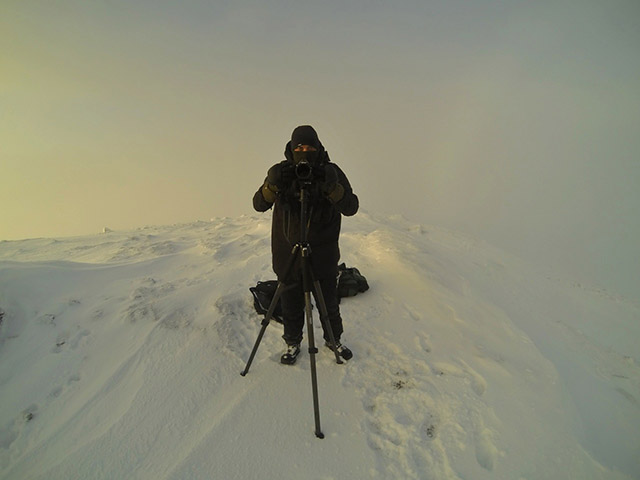
Image: Benjamin Pothier
“The body is as much an interface with the landscape as the camera or the microphone,” artist and anthropological researcher Benjamin Pothier tells We Make Money Not Art. When not studying nomadic behaviors or flying drones, he’s field recording the great -5°C outdoors, staying very still in the snow, against bitter winds. Pothier’s ARS BIO ARCTICA residency at the Kilpisjarvi Biological Station in Lapland comes to an end on December 1st, though he also participated in the Arctic Circle Residency last year, where he “had to take a zodiac boat every morning to go to the shore, protected by three armed guide against potential polar bears attacks.”
You might be asking yourself, especially if you’re enjoying your escape from last week’s Polar Vortex… why? Pothier is interested in the root impulses and reasons in creative human behavior—”Why did the human species started to draw, to do sculptures, embroidery… and why don’t we embroider our clothing nowadays? What is an object?”—and the extreme environments and its isolated dwellers seem to offer plenty of perspective.
Aside from first-hand survivalist training, dealing with it is also about keeping the right state of mind. “I have a kind of ‘preppers’ mindset. But in a ‘philosophical’ point of view,” he says. He is having a “Zen type experience” up there, becoming one with nature for a few minutes at a time. And he’s happy.
Browsing other Arctic Circle Residency projects, we came upon some work by Karl Erickson, like this prismatic, loop-filled “Ice for Arctic” video to sounds by Sandy Gordon, made with “dry ice applied to mic-ed metal” speaking to the “wary, often violent inter-connectedness we have with polar environments.” Severe as it sounds, the work feels kind of cheerful.
Artist Melissa F. Clarke has been researching and making work based on glacier terrains since 2009. “Untitled Antarctica,” a particularly memorable project that led up to her expeditions in the Arctic sourced seismic images to fabricate a “generative,” playable sculpture. Its layered glass ridges directly correlated to the data, particularly of icebergs digging into natural surfaces. In “Untitled: Ice Gouge for Performance,” a piece at Silent Barn, the sound artist used her own field recordings of glaciers cracking in Greenland, manipulated by running contact mics over the surfaces of the sculpture. We asked Clarke, who is from Syracuse with family in snow-enveloped Buffalo, if she related to Pothier’s “body as interface” statement.
“Cold, ice and extreme weather, it’s in my blood so to speak,” Clarke tells us. “I was [in Greenland] during the summer. To me, it was like a the nicest winter weather one experiences growing up in Central New York. So for me, the visceral, bodily experience—the personal interface so to speak—that I had with nature in the Arctic had more to do with scale, in the sense that I felt dwarfed by the size of the ice sheet and the bergs. And the resulting aesthetics of my work were definitely affected by this. Hearing the boom of the bergs breaking off from large glaciers at night and rocking back and forth in the boat in the vast open water was humbling.”
Another “interface” for Clarke was experiential context— “being in small boats with native Greenlanders and experiencing that largeness of ice and water in context of the local culture, people living with ice and all around me.”
The theme in these artists’ experiences seems to be acceptance of an unwelcoming landscape and its giant, chilly chunks as things much bigger than us. It is, by nature, a part of our experience of living on this planet, and, in a sense, a part of us. It’s not the most warming thought in the world, but there’s a strange comfort to it. Now pass the HotHands.


Comments on this entry are closed.